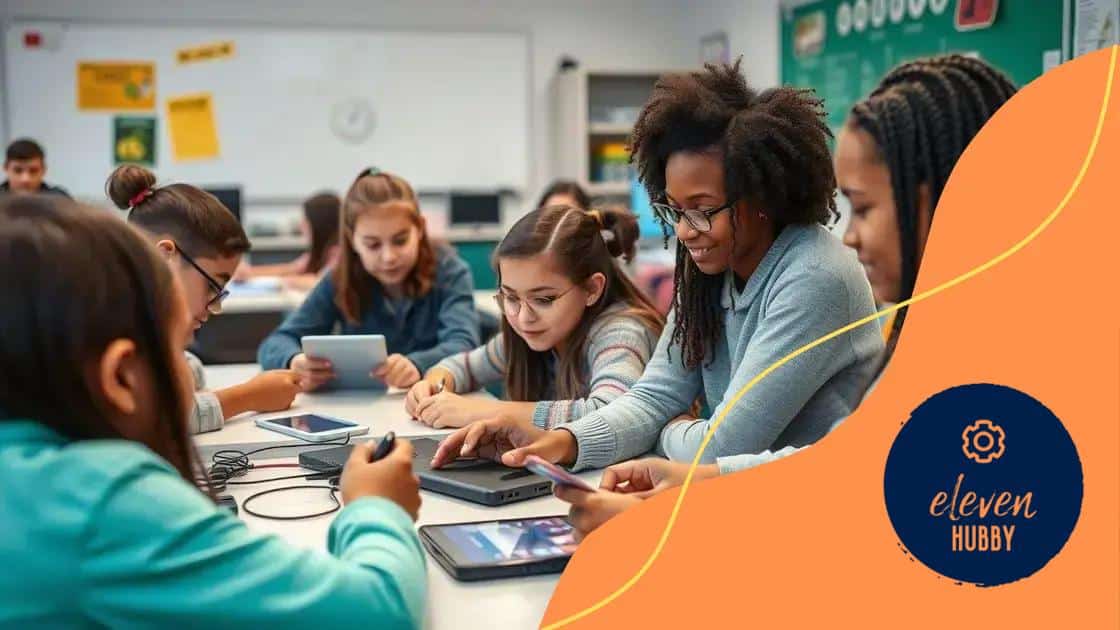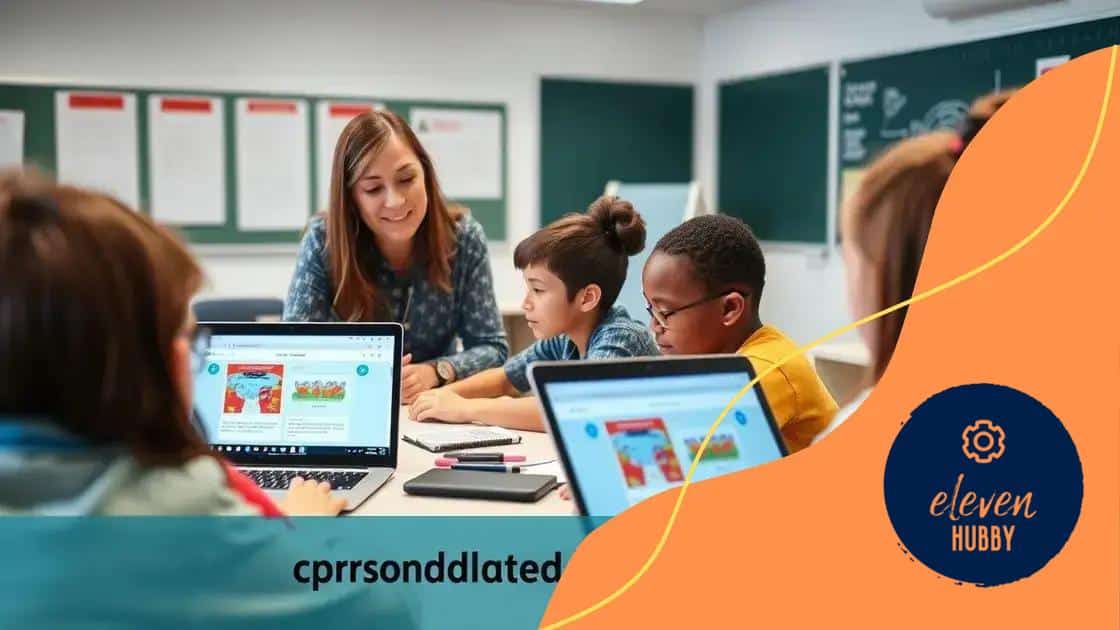Trends in adaptive learning technology for diverse learners

Trends in adaptive learning technology enhance personalized education by tailoring learning experiences to diverse learners, leveraging AI and interactive tools to promote engagement and facilitate lifelong learning.
Trends in adaptive learning technology are shaping the future of education. As classrooms become more inclusive, understanding these trends is vital for educators and learners alike. Have you ever wondered how technology can tailor learning experiences for every student?
Understanding adaptive learning technology
Understanding adaptive learning technology is crucial in today’s educational landscape. It offers personalized learning experiences tailored to meet the needs of each student. By integrating data and analytics, this technology adapts content in real-time, ensuring learners receive the support they need.
What is adaptive learning?
Adaptive learning refers to systems that adjust the educational content based on individual learner performance. This technology relies on algorithms to evaluate a student’s strengths and weaknesses. Through persistent engagement, it modifies the learning path, enhancing knowledge retention.
Key features of adaptive learning technology
Some features of adaptive learning systems include:
- Real-time feedback to guide learners.
- Customizable learning pathways.
- Access to resources based on individual needs.
- Progress tracking to celebrate achievements.
This approach not only promotes self-paced learning but also motivates students by acknowledging their progress. Everyone learns differently, and adaptive learning technology embraces these differences.
The impact on diverse learners
For diverse learners, adaptive learning technology creates an inclusive environment. It accommodates various learning styles and paces, ensuring all students can thrive. Whether a student excels in math or struggles with reading, adaptive technology caters to their unique needs. Schools can now utilize these tools to improve engagement, retention, and overall student success.
Benefits for diverse learners
The benefits for diverse learners from adaptive learning technology are significant and transformative. This technology caters to various learning needs, creating an inclusive educational environment. Each student can progress at their own pace while receiving the right level of support.
1. Personalized Learning Experience
With adaptive learning, educational content is tailored specifically to each learner. This customization helps prevent students from feeling overwhelmed while also challenging them appropriately. Everyone learns differently, and adaptive systems adjust to fit those differences.
2. Increased Engagement
Students are more engaged when the material aligns with their interests and skill levels. Adaptive learning tools enhance interaction by providing content that resonates with learners. When students see progress, they gain confidence, leading to higher motivation.
- Use of gamification elements to make learning fun.
- Immediate feedback encourages active participation.
- Variety of content formats keeps lessons interesting.
By emphasizing staggered learning paths, adaptive systems draw learners in, making education a more fulfilling experience.
3. Improved Outcomes
Research shows that adaptive learning technology positively impacts academic performance. It helps close learning gaps by concentrating on areas where students need extra support. With real-time assessments, educators can adjust their teaching strategies to better serve their students.
The result? Enhanced comprehension, improved test scores, and a stronger foundation for future learning.
How adaptive learning personalizes education

Adaptive learning personalizes education in remarkable ways. It uses data to tailor learning experiences to fit each student’s unique needs. This ensures that every learner receives the appropriate challenges and supports, helping them to succeed in their educational journey.
Customized Learning Paths
One of the core features of adaptive learning is its ability to create customized learning paths. By analyzing how students perform on quizzes and assignments, the technology adjusts the content to match their skill level. This method fosters a deeper understanding of the material as students are not forced to keep pace with a generic curriculum.
Real-Time Adjustments
As students progress, adaptive learning systems make real-time adjustments to their learning experience. When a student struggles with a concept, the system can detect this and offer additional resources or alternative explanations. This creates a supportive learning environment that encourages growth without frustration.
- Immediate feedback helps students correct mistakes.
- Interactive elements engage learners more deeply.
- Varied content types cater to different learning styles.
This continual support boosts confidence and mastery of subjects, making education more effective and enjoyable.
Empowering Educators
Adaptive learning also empowers educators by providing them with valuable insights. Teachers can see which concepts students grasp and which areas need more attention. This data allows educators to adjust their teaching strategies, ensuring they meet the diverse needs of their classroom.
Current trends in adaptive learning tools
Current trends in adaptive learning tools reveal how technology continues to evolve in the educational landscape. As classrooms become increasingly diverse, these tools are essential for meeting the varied needs of students. Educators and institutions are embracing innovative methods to enhance learning experiences and outcomes.
1. Integration of Artificial Intelligence
Artificial intelligence plays a significant role in adaptive learning. AI algorithms analyze student data to provide personalized recommendations and content. This technology enables teachers to offer targeted support to students, improving engagement and retention.
2. Mobile Learning Applications
With the rise of smartphones and tablets, mobile learning applications are gaining popularity. These apps allow students to access educational content anytime, anywhere. They help bridge the gap between in-class and out-of-class learning.
- Flexible access to resources enhances learning opportunities.
- Gamification elements make learning interactive and fun.
- Progress-tracking features motivate students to continue.
Such convenience ensures that learning is not confined to traditional settings, encouraging students to learn at their own pace.
3. Social Learning Integration
Another trend is the integration of social learning into adaptive tools. Platforms now allow students to collaborate and interact with peers. By participating in discussions and group activities, students learn from one another, further enhancing their understanding.
This collaborative environment fosters a sense of community and shared learning goals. As students work together, they develop important skills such as communication and teamwork, which are vital for their future success.
Future outlook on adaptive learning technology
The future outlook on adaptive learning technology is promising and exciting. As education evolves, these technologies will play a crucial role in shaping learning experiences. With advancements in artificial intelligence, data analytics, and user-centered design, adaptive learning is becoming increasingly effective for diverse learners.
1. Enhanced Personalization
In the future, adaptive learning tools will provide even greater levels of personalization. They will use sophisticated algorithms to analyze vast amounts of data, enabling them to tailor content to individual learning styles and paces. Students can expect lessons that are even more finely tuned to their specific needs.
2. Integration of Virtual and Augmented Reality
Another exciting trend is the integration of virtual and augmented reality in adaptive learning. These immersive technologies will allow students to engage with content in new and interactive ways. Imagine a history lesson where students can virtually walk through ancient civilizations or a science class where they can manipulate 3D models.
- Enhanced learning through real-world simulations.
- Increased engagement with interactive environments.
- Opportunities for experiential learning beyond traditional classrooms.
Such experiences can deepen understanding and retention of information.
3. Lifelong Learning and Skills Development
As the job market continuously changes, adaptive learning will also support lifelong learning. These technologies will provide learning pathways for individuals aiming to acquire new skills throughout their lives. Customized courses and resources will help meet the evolving demands of various industries.
By making learning more accessible and relevant, adaptive technology will empower learners to thrive in a constantly changing world.
FAQ – Frequently Asked Questions about Adaptive Learning Technology
What is adaptive learning technology?
Adaptive learning technology is a personalized educational approach that adjusts the learning content based on individual student performance and needs.
How does adaptive learning improve student engagement?
By tailoring lessons to fit each learner’s style and pace, adaptive learning keeps students more interested and motivated in their studies.
What role does artificial intelligence play in adaptive learning?
Artificial intelligence analyzes student data to offer personalized recommendations and supports, enhancing the learning experience.
Can adaptive learning tools support lifelong learning?
Yes, adaptive learning tools provide pathways for individuals to continuously acquire new skills throughout their lives, supporting lifelong education.






